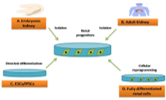Abstract
The recognition of kidney failure as a complex disease requires multi-factorial therapy in order to correct the conventional non-factorial deficiency. Firstly, self-renewal means the ability of most organisms to reproduce without separation or aging; secondly, more than one form of a mature somatic cell is identified by each of the three regardless of kidney disorders, it can lead to loss of the environment, often bacterial infections. The reconstruction of the kidney has produced a spectacular response in this framework. The restoration of weakened and new kidneys is an alternative to renal replacement therapy. Both teratomas and embryoid bodies consist of three different layers of embryonic germs. Induced pluripotent stem cells (iPSCs) and embryonic stem cells (ESCs) are present. These either provide useful therapeutical resources or can explore pathophysiology, including kidney diseases or infection. The benefit of ESCs is that they are relatively quick to receive and no longer subject to licensing/realty fees. Nevertheless, there are still some major concerns, such as ethical issues, the high risks to degeneration of neoplasm and immuno compatibility. The great benefit of iPSCs is that they have the same genetic history they drive making them an excellent method for studying the impact of genetic variants on disease path the key risk associated with the use of iPSCs are oogenesis, Tumorigenicity, and immunogenicity, the presence of an epigenetic memory, technical and economic issue associated with their long turnaround time and the presence of loyalties are the key risks associated with the use of iPSCs. Human pluripotent SCs have two major areas of use in kidney regeneration: they can be used by way organoid, scaffold, organ-on-a-chip, or blastocyst experiment to develop a "new kidney" or part of it. For encouraging us to hypothesize their medical use, a deeper understanding of the biology of pluripotent SCs is necessary.
Full text article
Authors

This work is licensed under a Creative Commons Attribution-NonCommercial-NoDerivatives 4.0 International License.

